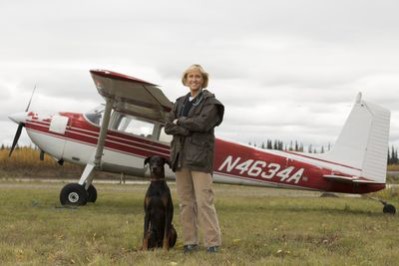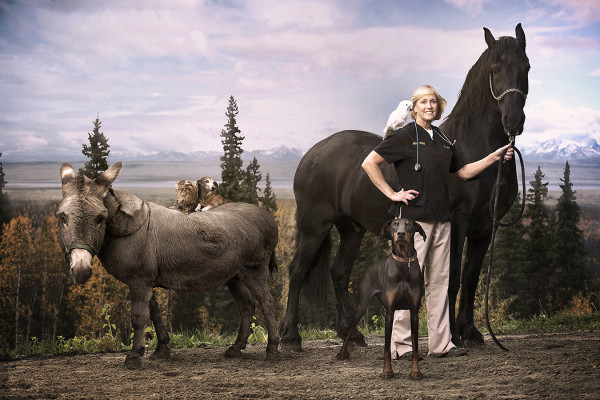INTERVIEW: Helping dogs, cats, eagles, moose on ‘Dr. Dee: Alaska Vet’

Way up in the far reaches of Fairbanks, Alaska, Dr. Dee Thornell tends to animals, both domesticated and wild, in her uniquely positive and supportive manner. She’s a woman who moved from the Midwest to Alaska 33 years ago, and now it’s her mission to help these critters with their host of problems.
However, what makes Thornell different than the many veterinarians in the lower 48 is that she has her pilot’s license and routinely travels to the remotest villages in Alaska to help pets that are far from the larger towns and cities.
Thornell’s adventures are the subject of the new Animal Planet series, Dr. Dee: Alaska Vet, which premieres on Animal Planet Saturday, Nov. 7 at 8 p.m.
“I just have fun, and don’t say no if I don’t have to,” Thornell said recently during a phone interview. “I do love animals. It’s just a nonstop energy and fun — not always fun, of course. In my line of work, there’s always sad times, too, but it’s all learning. And we keep going forward trying to make it as positive as possible.”
When Thornell first arrived in Alaska more than three decades ago, she set up her clinic in the back of a pickup truck. It had an enclosure, and she would go around on the road and help out where she could. One of the most popular, and vital, practices she offers is spades and neuters.
“And the community would come to me at the local area where we chose, and then I would take care of their animals,” she said. “So they didn’t have to carry them or bring them all the way down to Fairbanks. But eventually, what I did is got a little, 800-square-foot place, and it just grew. … Pretty soon I bought my own place, which now, it’s 13,000 square feet.”

There are plenty of pets, even in the remote areas of Alaska, that need veterinary care. With two nearby military bases, and the population of the Fairbanks area sometimes ballooning to more than 30,000 people, Thornell is a busy doctor.
“So, yeah, it’s a big community with a lot of pets, and then you’ve got all the native villages that need some kind of attention,” she said. “And that’s where I really wanted to get out and see Alaska. I do like the wild, so I got my pilot’s license. And so my husband flies, too. We go together, so it makes it safer. And now we’re going from place to place going and doing spades and neuters in the villages.”
Thornell and her team offer the spades and neuters through a nonprofit organization. She gathers sponsorships for the planes, and she takes the medicines with her when traveling. “So we do those [remote clinics] on the weekends, and so we work all week,” she said. “But, you know, weather up in Alaska is so questionable. … So some days we’re out there every single weekend, and sometimes we sit there for a month without helping. So we try to get somewhere though and dig it out.”
Some of the unique animal troubles that she sees usually are associated with the colder temperatures in Alaska. For example, animals, especially cats, often come to the clinic who have frostbite.
“Our sled dogs and any dogs that are running through the snow, especially if they are the male of the species, we have a lot of frostbite,” she said. “And pad injuries. We have a lot of dog mushers with pad injuries, and then because we have dog mushers, we also have dogs with a lot of sports injuries. You know, ligaments and tendons because they are pulling, and it’s a way of life. They use these dogs to get out and go places, and then on the weekends, they have fun with them. In the village, sometimes they’ll have little short races just amongst themselves, and they have some fun with the dogs.”
Even though she sees more frostbite among her patients than most veterinarians, Thornell reported few problems with ticks, a common problem for dogs in the lower 48. However, recently, the local area has seen an uptick in the number of ticks. “Some tickets were brought up on dogs and were boarded at a place made of wood, and they infested the place,” she said. “And they proceeded to infest a bunch of dogs, and actually Fish and Wildlife usually only saw one maybe two ticks a season. And all of a sudden they saw 90, so now they’re afraid that we do have ticks. … We see a lot more lice. We see quite a lot of lice in Alaska. That’s a dark winter month kind of problem, too, that we see with mainly the huskies and the outdoor dogs.”
Her line of work doesn’t begin and end with domesticated dogs and cats. In Alaska, there is a host of exotic animals a well. One time it was a gigantic iguana. She’s also seen her fair share of beavers, moose, eagles, owls and ravens. One time there was a den of foxes. “I do have a black bear that actually was a cub when it was first found and is in a certified area that someone has raised, and she’s still my patient,” Thornell added.
When assisting with wild animals, the veterinarian’s team tries to connect the hurt animal with a rehabilitation clinic, such as Bird Treatment and Learning Center (TLC) in Anchorage, Alaska. “[There’s] an actual airline called Raven Air that flies anything that goes to Bird TLC for free,” she said. “So whenever we find injured birds, the eagles or ravens that are protected, we have about 48 hours that we can take care of them and get travel arrangements to get out of there. And then if we find some other wildlife that somebody brings to us, it is kind of dependent on if they can find a permit that someone is like looking for a moose or someone that’s looking for beaver.”
With Dr. Dee: Alaska Vet, Thornell hopes to educate viewers on the responsibility that comes with pet ownership and companionship.
“I think my big goal is to make sure people really look at all these different gamuts of animals you have, and before you go and purchase one to have in your home and share your life with, to practice what I call going into the future and time-warping,” she said. “And looking at yourself, thinking, closing your eyes, putting your virtual reality map on, and go, I’m in my house. I’ve got this pet next to me. I got to get up. I got to feed it. How am I going to get up 15 minutes early? Can I feed it? Where is it going to go to the bathroom? I’m going to make a commitment to go and spend this many minutes per day, and where am I going to take those minutes out of my busy day? Or do I have a lot of time? Just really look at the animal, and the size of your apartment and your lifestyle, before you jump right in and buy a pet.”
She added: “Do you want little dog, a big dog? You certainly don’t want a great Dane in a 800-square-foot apartment. … So I really kind of coach my patients and my clients, even if they have questions, to come to me. So that’s what I’m looking for is somebody that’ll really pay attention to what you buy and what you get yourself into, and don’t be impulsive when it comes to buying a pet because it’s truly a commitment. It’s a marriage to a little fuzzy creature.”
By John Soltes / Publisher / John@HollywoodSoapbox.com
- Dr. Dee: Alaska Vet premires Saturday, Nov. 7 at 8 p.m. on Animal Planet. Click here for more information.

